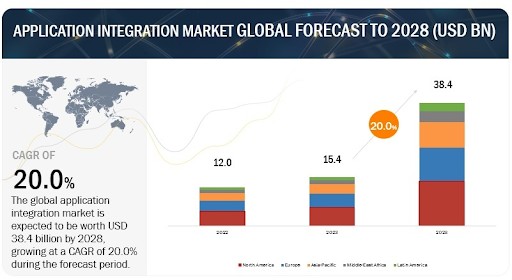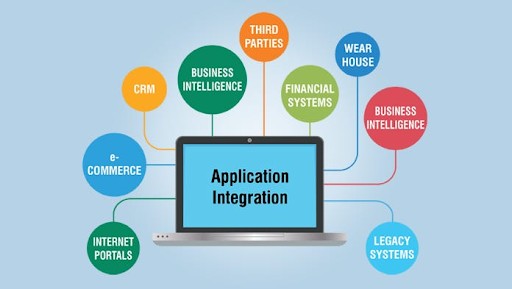In today's fast-paced digital world, businesses are constantly seeking ways to streamline their processes and improve efficiency. One crucial aspect of this is application integration. But what exactly is application integration? How does it work? And why is it so important for businesses? In this blog, we will dive into everything you need to know about application integration, from its definition and benefits to different types and best practices. So, if you're ready to elevate your business processes and stay ahead of the game, keep reading!

What is Application Integration?
Think of Application Integration as a bridge between information islands in your business. In essence, it's a process that enables all your powerful IT applications to understand each other and exchange information. This can involve applications within your own company, or applications across different entities.

It's like having a jolly good interpreter, one who sees to it that everybody is talking the same language, and thus avoiding misunderstanding and improving efficiency. The ultimate ideal of Application Integration is a series of perfectly integrated applications. Information is sent to the right place at the right time with the minimum of human interference. The result? Higher productivity and lower costs for your business.
Why is Application Integration Important?
It might be like trying to assemble a jigsaw puzzle in which the pieces are in all the different rooms of the house. Difficult, isn't it? This is what it's like when your business applications live in isolation with each one holding a portion of your company's data. Integrating these applications spreads all the puzzle pieces out on one table, and the complete picture is thereby much easier to see. Today, in the digital era, various software applications are used for different functions, so this integration is necessary.
This bridges the gap between these applications, allowing them to exchange information and functions easily. The result? A business environment integrated from data-driven insight, to streamlined acts, to proactive customer service. That's the power of Application Integration. It puts order to chaos, turning your business operations from splintered to integrated.
Different Methods of Application Integration
Just as there are various languages across the globe, there are different methods of application integration to make sure all your applications can 'converse' seamlessly. Among these, three commonly used techniques stand out - point-to-point, hub and spoke, and network-centric. Imagine point-to-point as a direct call between two friends, simple but can get messy when the circle grows. The hub and spoke method is similar to a busy airport where all communication is routed through a central hub. Lastly, the network-centric approach is like a social network, where all nodes (applications) can communicate freely, making it more complex yet highly scalable. Each of these methods has its pros and cons, and picking the right one depends on your business needs, just like choosing the right communication channel depends on your message and audience. It's like tailoring a suit; the perfect fit depends on your specific measurements and requirements.
The Role of APIs in Application Integration
APIs, or Application Programming Interfaces, are the unsung heroes in the world of Application Integration. Just like an interpreter at a multilingual conference, they allow various software systems to converse freely and easily. By defining a common set of rules with which different systems can exchange and perform operations, APIs let integration be done more directly and easily.
Like a trans-national adapter, they let software applications link up, carry on dialogues, and pass data and functions across all boundaries. Thus, through APIs, different applications can get together to sing in harmony. The isolated data are transformed into a chorus of shared information. They ease the burdens of the bewildering by making Application Integration more an adventure of seamless connectivity and data flow than a frightful business. APIs are the conductors of the orchestra that is your business operations, and do indeed ensure a flawless performance.
Application integration and workflow efficiency
It's like trying to bake a cake but all your ingredients are in different rooms. That's like your company trying to run with different software systems for different departments. These are all equally vital pieces of data, but the task is to pull them all together. Now is where Application Integration enters the scene. It's like the chief executive, gathering all your ingredients, mixing them all together, and serving up the ideal cake.
It eliminates data silos, providing real-time data access and automating business processes by integrating data from various sources. It results in a major decrease in the amount of data entry work done by hand and a huge boost in productivity. Application Integration means, of course, that you'll have your cake and eat it too, enjoying the efficiency of your finely tuned workflow.
Struggling with complex Application Integration challenges? Let our expert mobile app development company streamline your solutions!
How Application Integration Can Enhance Customer Experience?
Every instrument should play in tune in a symphony. Likewise, in terms of customer experience, harmony among your applications can make your customer journey a beautiful symphony. Its magic: It can get the various software systems in your company to work together, especially your CRM with others. Orchestrated together, these customized interactions and short response times hit the right chord every time.
Further, this provides the foundation for cross-channel consistency, so that no matter how your customers get in touch, they get a great experience. Meanwhile, you bask in the brilliant climax of customer satisfaction and loyalty. Indeed So, let Application Integration be your maestro, fine-tuning your customer experience into a masterpiece that harmonizes with every customer, every time.
Application Integration: Financial Benefits
It turns out that the alchemy of Application Integration has a golden touch that goes well beyond the confines of operational efficiency. It also wonders on your balance sheet. Think about a factory where people have been replaced by the latest industrial technology, increasing the volume of production and reducing expenses. That's precisely what Application Integration does for your business. It reduces labor costs to a considerable extent by automating repetitive tasks, or eliminating unnecessary manual data entry.
On the other side of the balance sheet, in other words, it makes for faster, data-based decision-making and possibly greater revenue streams. But apart from that initial outlay, like a good investment in the stock market, Application Integration can easily bring a high return on investment. In the financial symphony that is your business, let Application Integration be the maestro who leads an ensemble of savings and revenue increases.
Overcoming Challenges in Application Integration
As with any journey, the road to Application Integration is unlikely to be completely smooth. Sometimes data security, complicated implementations and system compatibility issues seem like unsurmountable mountains. But don't worry, with a well-equipped backpack, a comprehensive map (a well-planned strategy), and a sophisticated guide (a talented IT team), you will be able to conquer these obstacles.
Planning is your compass; it leads you clear of the dangers and directs you to a safe landing. Although it is a bit of a tough climb, remember that with every step you take you are helping create a cohesive, well-run, and data-driven enterprise. So, get ready and go for it. The trail of Application Integration will have its challenges, but you can face it with confidence.
The Right Application Integration Platform
Starting to trek on the road of Application Integration, the most important decision you will make is that of your integration platform. View this hub as a spacecraft, one constructed to pilot your applications all across the great expanse of your business, and make sure they are all perfectly aligned. Your ideal platform should not only fit like a glove with your existing systems, it must also grow and scale with you as your business changes.
In the world of digital information, potential threats can lurk at every corner, so it is essential that we ensure that the platform we select has powerful security systems. Just as you would want ground control around for your space adventure, look at the level of support the vendor provides. With these thoughts in mind, you will be able to come to an informed decision about the perfect platform for your business's journey of Application Integration.
IT Professionals Role in Application Integration
So, moving into the world of Application Integration, just imagine your IT personnel as old-fashioned explorers, taking you through unknown territory. Navigators choose the best integration strategy to suit your business's unique landscape. They are like highly qualified engineers, and need to be responsible for actually carrying out the work, allowing the parts of your business machine to run smoothly together.
However, their role doesn't end at implementation, they can also serve as the rescue team, eliminating any bumps that may appear throughout the course of the trip. Most important, they're your business agents, maintaining the newly integrated system in a way that serves your needs as best as possible. Application Integration is an expedition, and those experts in IT are, indeed, multi-dimensional guides who will take you to your destination.
The Future of Application Integration
With technology changing at lightning speed, Application Integration is right in there with the action. It is about to jump into a future that makes its role even more important. Imagine a reality in which clouds are not only in the sky, but also in computing. But as cloud-based services are increasingly adopted, integration solutions are also becoming more flexible and scalable. There's more, however: artificial intelligence is making its debut.
Imagine your integrated management systems no longer just as communication channels, but as intelligent assistants--able to learn, to predict, to automate. This Application Integration will open new doors to levels of efficiency and insight never before imagined. Such levels of efficiency and insight will help business take off like never before. And so strap in, because the future of Application Integration is going to be something of a roller coaster ride.
Embracing Application Integration in Your Business
In the grand symphony of your business operations, Application Integration is indeed the maestro, the grease that makes sure every instrument, every software application, plays in harmony. The integrating magic wand weaves threads of disparate data into a complete tapestry of actionable insight. It helps smudge over the rough edges of operations, fine-tunes the efficiency of your workflow, and magnifies the reverberation of your consumer experience.
Therefore, on the financial stage it hits the right balance between cost cutting and revenue growth. This journey to full integration will certainly have its obstacles, but as long as your strategy is fine-tuned, your IT platform is robust, and your team is highly qualified, you can win the day. With one foot in the future, Application Integration will take your business on a ride towards ever greater efficiency and growth. It's time to get into step with the masterful touch of Application Integration, and not let your business miss the beat.
Complicated Application Integration slowing you down? Hidden Brains has the solution—hire a mobile app developer to get started!
Conclusion
In this vibrant symphony of the digital age, Application Integration is the conductor shaping a smooth piece, transforming your business into a success tale of efficiency and growth. It bridges the gaps between siloed systems, helping unleash the value of your data, optimizing workflows, improving client experiences, and making better use of financial resources. Yes, the road to complete integration has a few bumps. However, with a sound strategy in place, a potent platform, and a strong IT team, you needn't fear those pot holes. But who knows where technology is going? Application Integration is gearing up to take your business on a wild ride to greater efficiency, scalability, and innovation.
But with Application Integration, you're not just keeping up with the digital revolution, you're powering your business forward into a future where every process, every decision, is guided by harmony and insight. Now it's time to turn up the volume: Strike the right chords, and let your business holler loud and strong with the powerful voice of Application Integration.
Frequently Asked Questions
Let's delve into some commonly asked questions around Application Integration.
- What is Point-to-Point Integration?
This is a method of integration where each application directly communicates with the others. While it's simple and straightforward, it can become complex and unmanageable as the number of applications increases.
- What is the role of APIs in Application Integration?
APIs, or Application Programming Interfaces, act like interpreters, allowing different software systems to communicate with each other. They enable software programs to connect, interact, and share data and functionalities, simplifying the integration process.
- How does Application Integration impact customer experience?
Application Integration can significantly enhance customer experience by ensuring consistency and customization across all customer interactions. By integrating your CRM with other systems, you can respond to customer needs more quickly and efficiently.
- What financial benefits can Application Integration bring?
Apart from boosting operational efficiency, Application Integration can also lead to financial benefits. It can cut down labor costs by automating repetitive tasks and enable quicker, data-driven decision-making, potentially increasing revenue streams.
- What challenges might I face with Application Integration?
Some common challenges include data security, system compatibility, and intricate implementations. However, with a well-crafted strategy, the right tools, and a skilled IT team, these challenges can be effectively navigated.
- How do I choose the right Application Integration platform?
Your chosen platform should align with your existing systems, scale as your business evolves, offer robust security measures, and provide reliable support. It's crucial to evaluate different platforms to find the one that suits your business best.
- What does the future of Application Integration look like?
The future is promising, with trends pointing towards more flexible and scalable integration solutions. The increasing adoption of cloud-based services and artificial intelligence will add more dimensions to Application Integration, leading to unprecedented levels of efficiency and insights.



